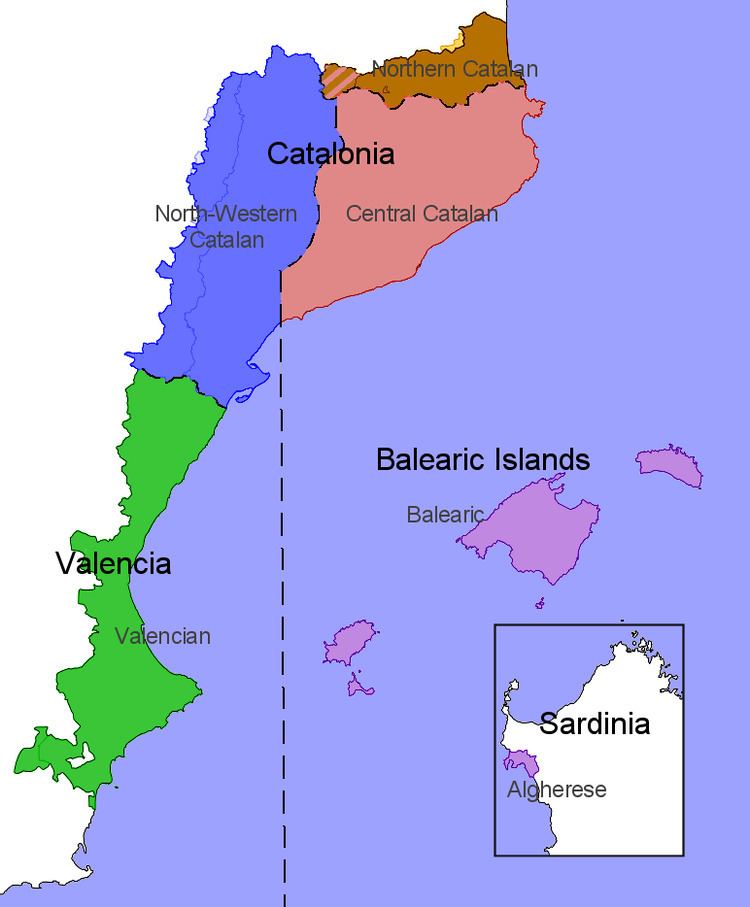 | ||
The dialects of the Catalan language feature a relative uniformity, especially when compared to other Romance languages; both in terms of vocabulary, semantics, syntax, morphology, and phonology. Mutual intelligibility between its dialects is very high, estimates ranging from 90% to 95%. The only exception is the isolated idiosyncratic Alguerese dialect.
Contents
Overview
In 1861, linguist Manuel Milà i Fontanals split Catalan into two main dialects: Western and Eastern. The most obvious phonetic difference lies in the treatment of unstressed a and e, which have merged to /ə/ in Eastern dialects, but remain distinct as /a/ and /e/ in Western dialects. There are a few other differences in pronunciation, verbal morphology, and vocabulary. Western Catalan comprises the two dialects of Northwestern Catalan and Valencian; the Eastern block comprises four dialects: Central Catalan, Balearic, Rossellonese, and Alguerese. Each dialect can be further subdivided in several subdialects.
There are two spoken standards for the language based on the Eastern and Western dialects respectively:
Valencians are only surpassed in number of Catalan-speakers by Catalans themselves, representing approximately a third of the whole Catalan-speaking population. Therefore, in the context of linguistic conflict, recognition and respect towards the dual standard, as well as the dual Catalan–Valencian denomination, pacifies the tense central–periphery relations between Catalonia and the Valencian country.
Vowels
Catalan has inherited the typical vowel system of Vulgar Latin, with seven stressed phonemes: /a ɛ e i ɔ o u/, a common feature in Western Romance, except Spanish. Balearic has also instances of stressed /ə/. Dialects differ in the different degrees of vowel reduction, and the incidence of the pair /ɛ e/.
In Eastern Catalan (except Majorcan), unstressed vowels reduce to three: /a e ɛ/ → [ə]; /o ɔ u/ → [u]; /i/ remains distinct. There are a few instances of unreduced [e], [o] in some words. Alguerese has lowered [ə] to [a].
In Majorcan, unstressed vowels reduce to four: /a e ɛ/ follow the Eastern Catalan reduction pattern; however /o ɔ/ reduce to [o], with /u/ remaining distinct, as in Western Catalan.
In Western Catalan, unstressed vowels reduce to five: /e ɛ/ → [e]; /o ɔ/ → [o]; /a u i/ remain distinct. This reduction pattern, inherited from Proto-Romance, is also found in Italian and Portuguese. Some Western dialects present further reduction or vowel harmony in some cases.
Central, Western, and Balearic differ in the lexical incidence of stressed /e/ and /ɛ/. Usually, words with /ɛ/ in central Catalan correspond to /ə/ in Balearic and /e/ in Western Catalan. Words with /e/ in Balearic almost always have /e/ in central and western Catalan as well. As a result, Western Catalan has a much higher incidence of /e/.
Consonants
-
Morphology
In verbs, the 1st person present indicative ending is -e (∅ in verbs of the 2nd and 3rd conjugation), or -o.
E.g., parle, tem, sent (Valencian); parlo, temo, sento (North-Western). In verbs, the 1st person present indicative ending is -o, -i or ∅ in all conjugations.
E.g., parlo (Central), parl (Balearic), parli (Northern), ('I speak').
In verbs, the inchoative desinences are -isc/-ixo, -ix, -ixen, -isca. In verbs, the inchoative desinences are -eixo, -eix, -eixen, -eixi.
In nouns and adjectives, maintenance of /n/ of medieval plurals in proparoxytone words.
E.g.,hòmens 'men', jóvens 'youth'. In nouns and adjectives, loss of /n/ of medieval plurals in proparoxytone words.
E.g.,homes 'men', joves 'youth'.
Vocabulary
Despite its relative lexical unity, the two dialectal blocks of Catalan (Eastern and Western) show some differences in word choices. Any lexical divergence within any of the two groups can be explained as an archaism. Also, usually Central Catalan acts as an innovative element.
